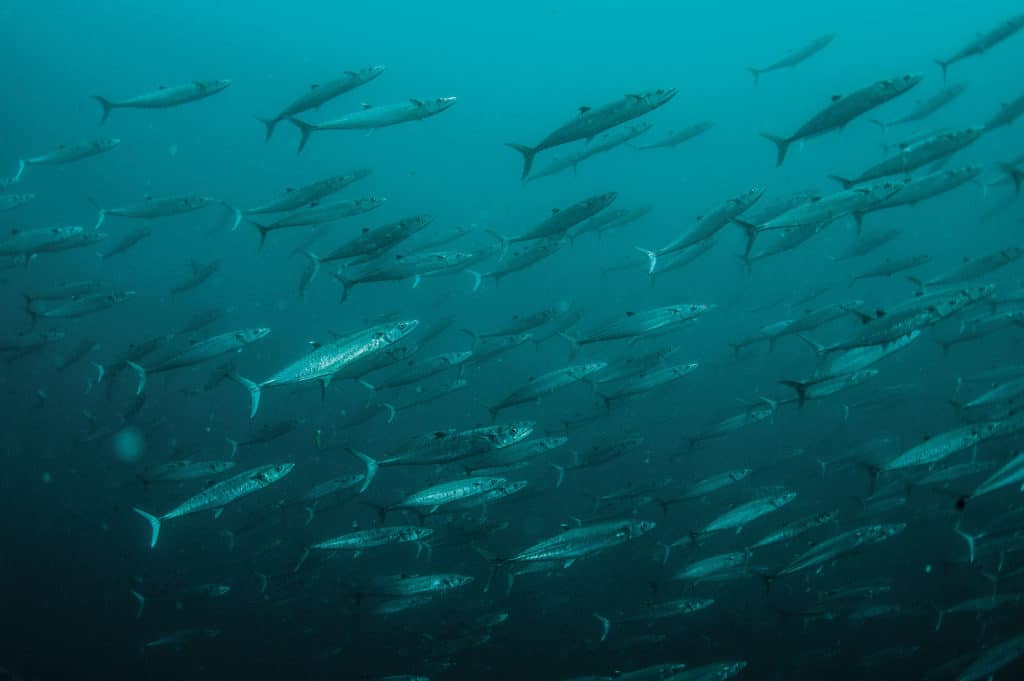
Many reefs go by colorful names — 8A off Port Canaveral isn’t one. In fact, we saw no visual clues to tell us — as Capt. Eric Castillo throttled back the three Merc 350 Verados on his SeaVee 370Z, 16 miles offshore — that we had arrived at any sort of special place. A group of king mackerel enthusiasts had joined me to venture forth from Blue Points Marina (bluepointsmarina.com) on this chilly late-February day, typically right in the middle of the year’s most productive weeks for kingfishing. Our guide that day, Kyle Kosiba, qualifies as one of Canaveral’s most knowledgeable and experienced kingfish skippers. He’s fished kings most of his life, as a recreational angler, a charter captain and a commercial fisherman.
Of course, Kosiba fishes for and catches plenty of other species, but he’s particularly enthusiastic when it comes to kingfish. And with good reason: When kings are stacked up and smacking lures and baits right and left, the pace of the action is tough to beat in any fishery.
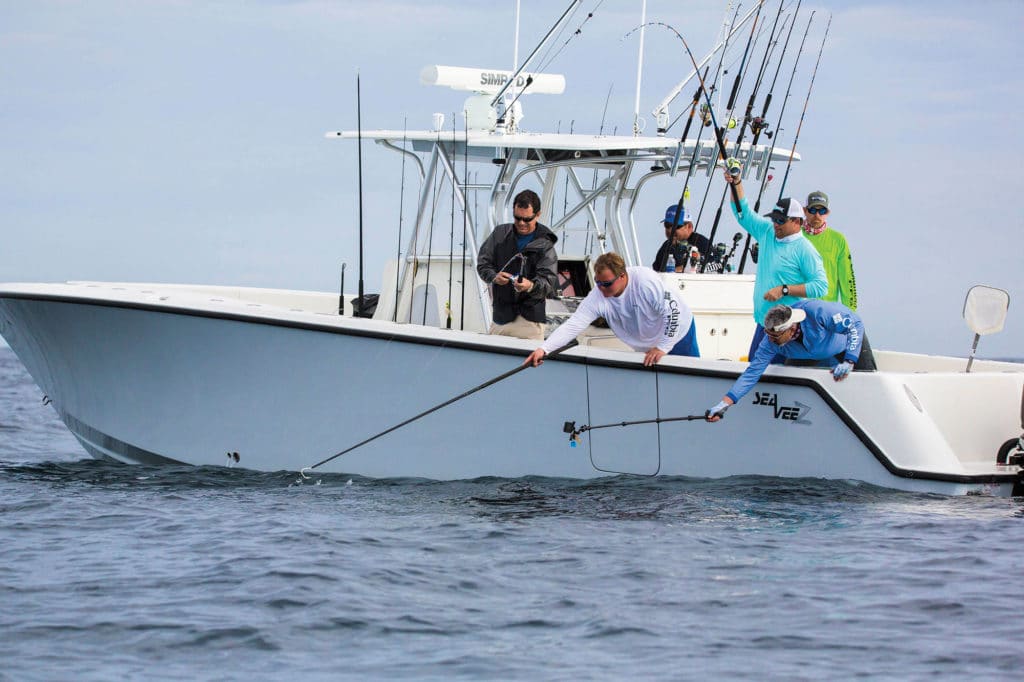
A Pause for Pogies
That describes the sort of action the half-dozen anglers on this outing hoped to see. The timing was right: Kosiba had advised us that late winter into early spring sees king mackerel numbers peaking. “That’s typically when big numbers of school-size fish are moving through, plus there are some big fish mixed in,” he says.
“Kingfish are a staple for [those of] us [who fish off north-central Florida]: They’re usually plentiful, eat well and are fun — they sky on baits and make sizzling runs.” That offers a pretty good summation of my own longtime appreciation of kings as a superb light‑tackle game fish.
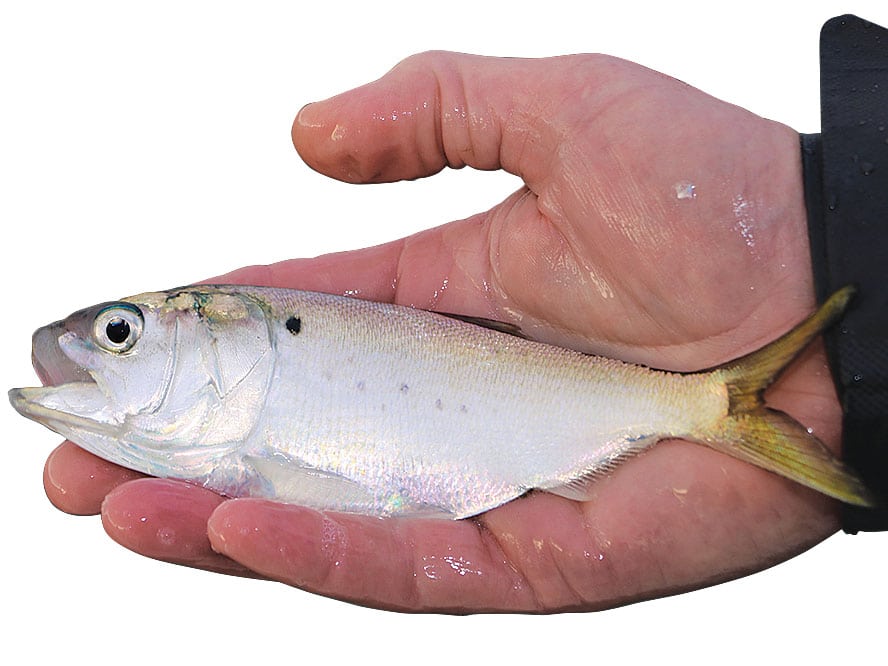
While plenty of anglers go out with no bait and do well catching kings on trolled lures, a baitwell loaded with liveys is an advantage — and offers a good chance to get the fish really fired up and skying on bait, lures and even flies behind the transom.
Accordingly, Kosiba had us loading up our gear on the SeaVee well before daylight. By the time Castillo had traversed the inlet and begun cruising south off the beach, watching for signs of bait, the first hints of daylight were peaking over an iron-gray horizon. The schools of small pogies (menhaden) that had been plentiful in recent days proved scarce, and an hour or so running along the beach and watching the dingy green water brought us little joy. But a bit later, we located some schools of the 6-inch silver fish, and Kosiba’s perfect cast-net throws paid off: Soon we were heading offshore with the SeaVee’s 40-gallon transom livewells reasonably crowded, if not teeming.

Marlin Chasing Kingfish
“We’ll usually fish the reef system from Pelican Flats to the south, the Lumps and 8A. These are all natural reefs, well-marked on charts,” Kosiba says. There’s some artificial structure around 8A as well, he adds.
Few charters or private boaters travel out here only to catch kingfish. Often that’s a primary target, but, “we catch anything and everything while targeting kings: cobia, sails, wahoo, dolphin. I’ve seen marlin chasing kingfish on 8A!”
On this day, once we made the 8A area, I saw not a single marlin, nor any other activity. A steady northeast breeze had put a bit of chop on the surface, which didn’t please Kosiba, who prefers it calm for kings. “In some spots, the kings just seem not to bite once the wind comes up,” he says.
It might be on that morning a combination of conditions and a limited supply of pogies to toss out as live chum kept kings from crashing on top for us. But, Kosiba says, on plenty of occasions, just as soon as you can throw out a few liveys, you’ll see kings skying on them. But generally more live chum is better. He’ll overfill the livewell if the bait is abundant and will chum heavily early in the trip, which opens up a bit of space in the livewell while also driving the kings into a frenzy.
Some anglers use dead chum, and it’s certainly quicker to buy that than to spend time searching for schools of pogies to cast-net. “But I’m not a fan of dead chum,” Kosiba acknowledges.
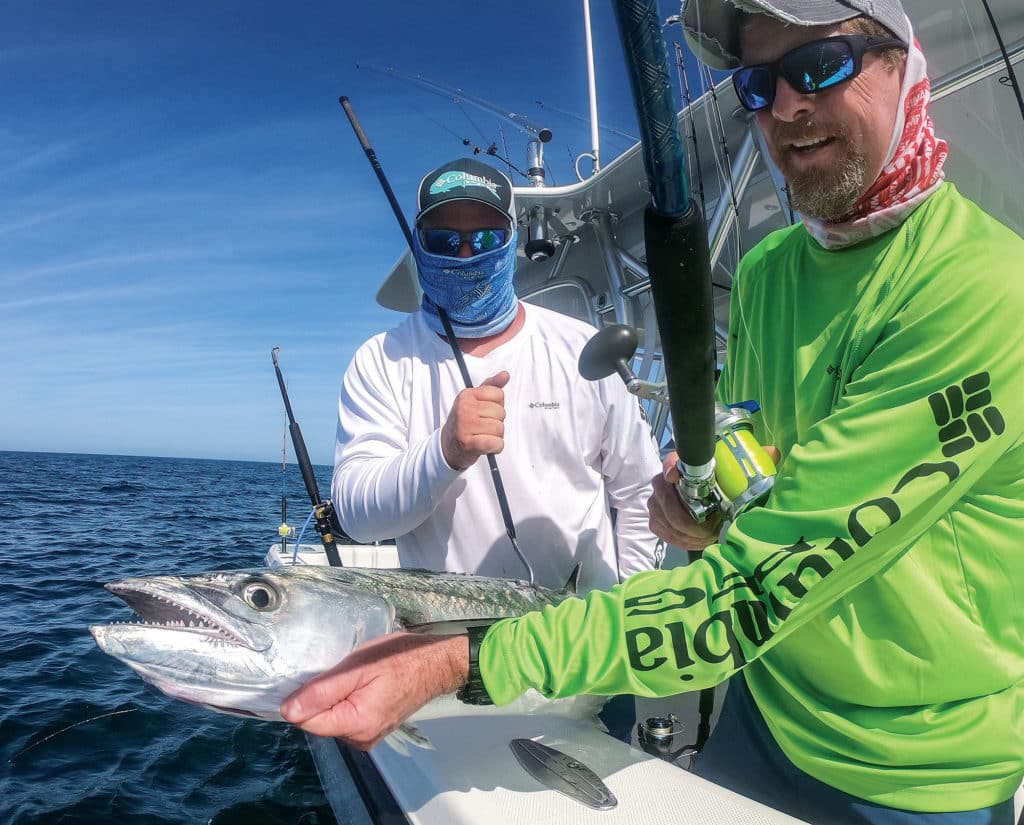
Thumb-Burning Torpedoes
While we didn’t get to see hungry fish busting on our baits as we’d hoped, the kings were there, as Kosiba said they would be. John Caballero, with SeaVee, discovered that just after fly-lining out a menhaden on a double treble-hook rig. With the reel in free-spool, it was all Caballero could do to avoid burning the skin off his thumb when a king snatched the bait and took off like a torpedo, a quintessentially kingfish moment.
Not long after that, we put out a livey underneath a kite, which produced a savage strike for Sport Fishing’s intrepid group publisher and kite expert, Scott Salyers. Still, Kosiba says, “hardly anyone here fishes kites for kings.” Although clearly it’s a technique that can be effective, “kites haven’t really caught on,” perhaps due in part to the fact that “the baits we use are smaller and harder to fish from kites.”
That’s not to say that plenty of larger greenies (threadfin herring), pilchards and hardtails (blue runners) don’t find their way onto live-bait hooks for kings here, as well as smaller menhaden.
And when the king bite is going off, a simple and straightforward approach should be all an angler needs to enjoy fast fishing. And so it went for us that morning at 8A, when putting out a live bait generally translated into strike-threat-imminent status. Double- and triple-headers kept anglers dancing along the gunwales as 15- to 25-pound kings sizzled wildly around the boat.
“We had that kind of really good fishing last year,” Kosiba told me, “with more days like that than I can recall. It just seemed like there was an endless amount of kings.”
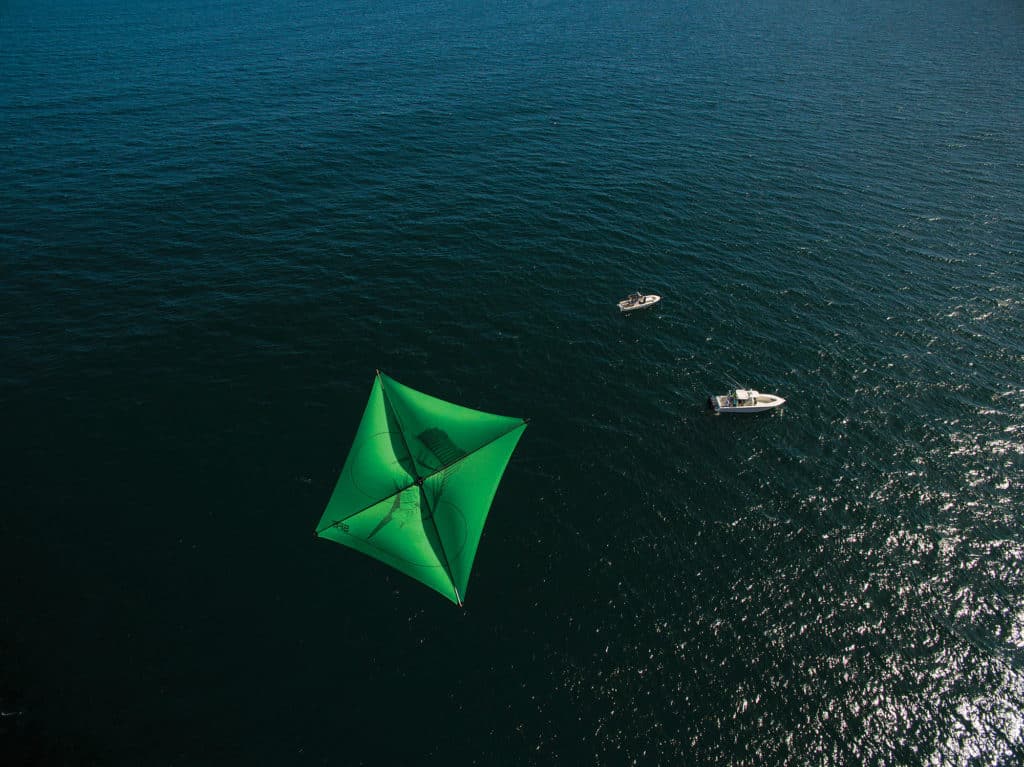
Tackle Testers
While winter often means great numbers of fish — as we discovered — it’s not the best time for smokers, Kosiba says. Anglers intent on hooking kings better than 30 pounds will get most of their shots during spring and well into summer. “Summer is when you’ll find the giants,” he adds, “from the reefs right in to the beaches.” Kosiba says some kings more than 50 pounds are boated each year.
When it comes to tackle, on the one hand, Kosiba says that “big kings are tackle testers. They make long runs, and fish after fish can be hard on gear.” But there’s a flip side to kingfish tackle: “The lighter you can fish, the better — unless you’re tournament fishing. It’s just more fun for experienced anglers.” Kids might need a bit heavier tackle, lacking experience to finesse the fish on light gear, but no matter: Kings are great entertainment for young anglers, the guide says.
Flies and poppers work best, of course, if the fish can be live-chummed into a frenzy. That’s also when to see the fish make eye-popping leaps clear of the water.
Anglers who enjoy working metal jigs should bring their tackle when in kingfish country. “Jigging is a great method for kings,” Kosiba says. “As long as you have some wind or current to keep the boat moving, it definitely works. Butterfly-type jigs usually get bit pretty quickly, but don’t forget the wire.” Kosiba says he’s won a couple of tournaments jigging while drifting over wrecks.
Read Next: World’s Biggest King Mackerel
But most kings fall to slow-trolled baits, live or dead. The double-hook rig with trebles that Caballero used is the norm for Kosiba, with the first treble hooked in the nose and the second in the bait’s side. I noted that even with six sharp points sticking out, somehow kings manage to leave anglers with half a pogy and a broken heart.
By the end of the day, I couldn’t really have said how many kings we caught (and, mostly, released). To me, the essence of kingfishing isn’t a numbers game; it’s about action. For those who love the feel of a blistering strike and the sound of a squalling reel drag, and who aren’t keen on long waits between bouts: Grab your light gear and chum up some kingfish.
Kingfish Variables
Kyle Kosiba, a top kingfish skipper, offers a short list for four variables of when and where in the quest for success.
Time of Day: “The early-morning bite for kings is where it’s at,” Kosiba says, adding that during the late afternoon, they can also turn on. But when they’re really thick, the bite can be pretty much throughout the day.
Cloud Cover: Doesn’t seem to make a lot of difference.
Wind: This variable is somewhat area-dependent, Kosiba says. In some spots, the fish don’t seem to want to bite when the wind comes up (from any direction), though in other spots, the wind seems less a factor. But wind affects water quality off north-central Florida, so a south wind results in cleaner water, but a wind from the north is more inclined to push in dirty water, and that makes the fish move out.
Depth: This varies greatly, though most often Kosiba is fishing in about 80 feet of water, give or take. But he points out that in summer, he might fish for big kings in 10 feet of water off the beaches, and at other times, might find them a bit farther out in 120 feet. Water temperatures and clarity, as well as the presence of bait, are big factors in figuring optimal depth. He also reminds anglers to keep an eye on the sounder because kings can and do range anywhere in the water column.
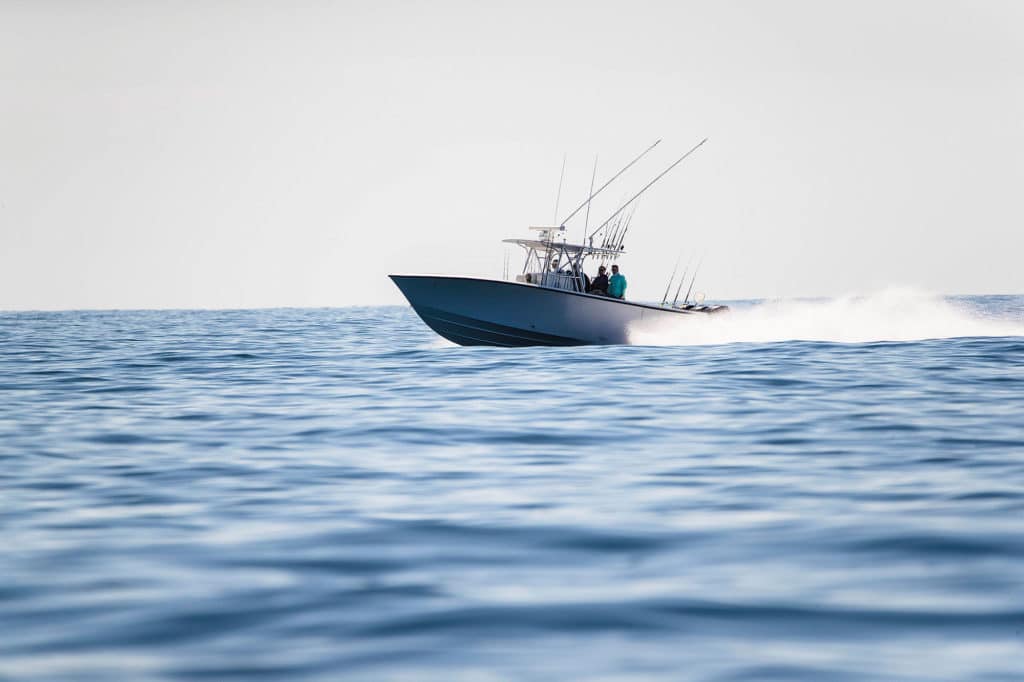
The opportunity to spend a day fishing on SeaVee’s 370Z made its great popularity pretty easy to understand. The beamy center-console offered so much open space fore and aft of the console that even with eight souls on board, six or even seven of them fishing at any one time, things didn’t feel crowded. Particularly impressive was its ride. Most of our day was pretty flat, though a breeze chopped up things a bit in the afternoon. Either way, it was a pleasure to be aboard when Capt. Eric Castillo dropped the throttles and let loose more than 1,000 horses on the transom. The 370Z’s stepped hull features multiple lifting bodies for a fixed running-trim angle. A four-port air-induction system uses a central air-reservoir unit to maintain air cavities that reduce drag. Finally, an array of speed rails helps directional stability, creating counterforce in high-speed turns.








